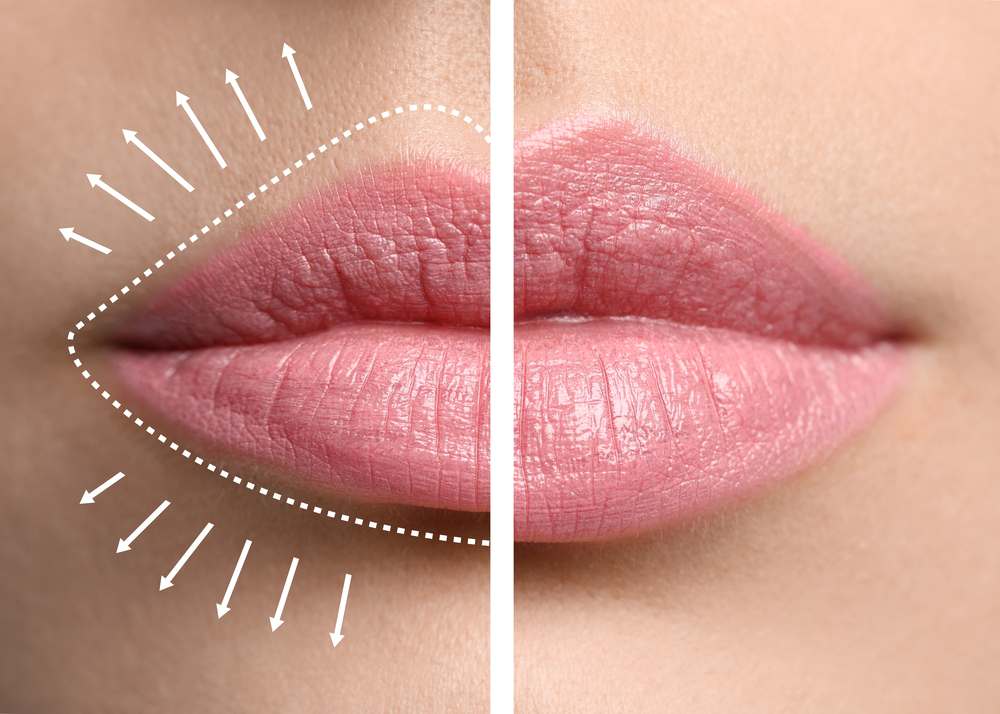
5 Most Common Questions People Ask About Lip Filler
Q1. What is lip augmentation? Is it the same as lip filler?
Lip augmentation is the umbrella term for procedures designed to enhance the size, shape, or definition of the lips. It can be achieved through both surgical and non-surgical methods.
- Non-surgical lip augmentation: This usually refers to dermal fillers, most often hyaluronic acid (HA) injections. These treatments are temporary, minimally invasive, and customisable to each person’s goals.
- Surgical lip augmentation: Options like fat grafting or lip implants provide longer-lasting results but involve more downtime and risk.
👉 Lip fillers are the most common type of lip augmentation. While all lip filler treatments fall under lip augmentation, not all lip augmentation procedures involve fillers.
This distinction is important: if someone says they want “lip augmentation,” they may mean any enhancement procedure, whereas “lip fillers” specifically refers to hyaluronic acid injections
Q2. What is the difference between lip fillers and lip injections?
The terms are often used interchangeably, but there’s a subtle difference:
- Lip fillers → the product itself, usually hyaluronic acid gel that adds volume, hydration, and structure.
- Lip injections → the procedure of injecting filler into the lips.
So when you hear “lip injections,” it refers to the treatment process, while “lip fillers” refers to the substance used.
Q3. Is it safe to inject hyaluronic acid into the lips?
Yes, injecting hyaluronic acid into the lips is considered safe when performed by a qualified medical professional.
Why hyaluronic acid is safe:
- Hyaluronic acid is a substance that occurs naturally in the skin, joints, and eyes.
- It is biocompatible and biodegradable, meaning the body gradually breaks it down.
- If results are unsatisfactory, hyaluronic acid fillers can be dissolved using an enzyme called hyaluronidase.
Expected side effects (temporary):
- Swelling and redness for 24 to 48 hours.
- Mild bruising.
- Tenderness at injection sites.
Rare but serious risks:
- Lumps or asymmetry if filler is unevenly distributed
- Vascular occlusion (a blocked blood vessel) — rare, but requires urgent treatment to prevent tissue damage
- Infection, if aftercare instructions aren’t followed
👉 The key factor in safety is who performs the treatment. A qualified injector with medical training will understand anatomy, recognise complications early, and apply correct technique.
Q4. What foods should I avoid after getting lip fillers?
After treatment, avoid foods and drinks that may increase swelling, bruising, or infection risk for the first 24–48 hours:
- Spicy foods – can cause irritation
- Salty foods – may worsen swelling
- Alcohol – thins blood and increases bruising
- Hot drinks – may increase discomfort or swelling
- Messy foods – avoid putting unnecessary pressure on the lips while healing
Best choices of food for healing after lip filler treatment
- Cool, soft foods like yoghurt, smoothies, or mashed potatoes.
- Plenty of water to stay hydrated.
- Nutrient-rich foods (e.g., fruits and vegetables) to support tissue repair.
Apart from consuming the right food to help recovery, following aftercare advice is also important. It not only improves comfort but also helps the filler settle evenly, giving you the best results.
Q5. How long does lip filler last?
Lip fillers are temporary treatments, with the result typically lasting 6 to 12 months. However, there are some factors that can affect the duration:
- Types of filler used:
Some brands and formulas are designed for softer, shorter-term results, while others are denser and last longer. - Individual metabolism:
People with faster metabolisms may break down the filler more quickly. - Lifestyle habits:
Smoking, frequent sun exposure, and high-intensity exercise can shorten longevity. - Placement technique:
Correct injection depth and distribution can help fillers last longer and look more natural.
Maintenance
Regular small adjustments often look more natural than waiting until all the filler dissolves and starting over. Therefore, many clients choose a top-up treatment every 6-9 months to maintain results.
Unlike permanent implants, lip fillers give you flexibility: you can maintain, adjust, or dissolve them depending on your preferences over time.
Conclusion
Lip fillers are one of the most popular non-surgical cosmetic treatments for enhancing the lips, but it’s normal to have questions before deciding whether they’re right for you. From understanding the difference between lip augmentation and fillers, to learning about safety, aftercare, and longevity, being well-informed helps you make the best choice for your goals.
The most important takeaway is that results and safety depend heavily on choosing a qualified medical professional. A comprehensive consultation will ensure your treatment is tailored to your unique anatomy, preferences, and lifestyle, giving you both confidence and peace of mind.
Important Notice:
A comprehensive consultation is essential before making any decisions regarding cosmetic injectable treatments. Our clinical team prioritises your safety and tailors all treatment recommendations to your unique needs. Individual results and recovery may vary. This content is for educational purposes only and does not promote or advertise the use or supply of prescription-only products.





